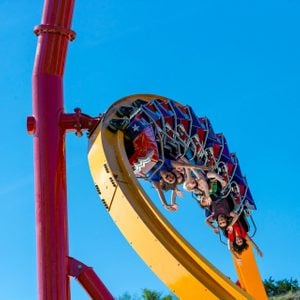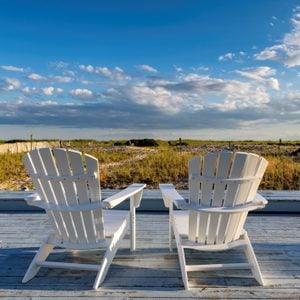17 Fascinating Facts About Water Parks That Will Make You Want to Visit One Now
Updated: Feb. 01, 2024
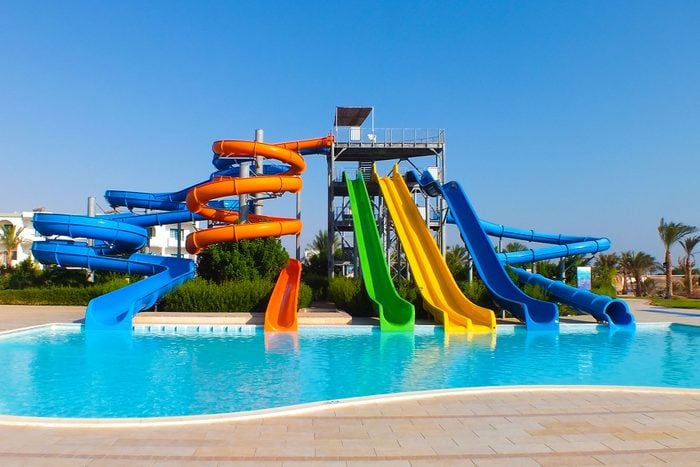
If you thought water parks sounded cool before, just wait until you read this!
If you’re looking to treat your family, a quick trip to a water park is bound to be a hit, whether you’re soaking up the sun in the summer or escaping to an indoor water park in those endless winter months. But while standing in line to speed down your favorite waterslide, have you ever really thought about everything around you. Like, who invented the first waterslide, anyway? How much water does it take to fill that wave pool? And where can you find the world’s tallest waterslide?
We found the answers to these questions and more. Read on to impress your family (and random line-mates) with these interesting facts about water parks.
Get Reader’s Digest’s Read Up newsletter for more travel, tech, cleaning, humor and fun facts all week long.
Water parks didn’t exist until the 1970s
The World Waterpark Association credits American businessman George Millay with inventing the water park. While he founded SeaWorld in San Diego in 1964, his foray into water parks that humans could enjoy in a whole different way didn’t come until a decade later. In 1977, he opened the very first Wet ‘n Wild water park in Orlando, Florida, and an entirely new industry was born. While Wet ‘n Wild officially closed in 2016, Millay’s legacy as the “father of water parks” lives on.
Waterslides are all about science
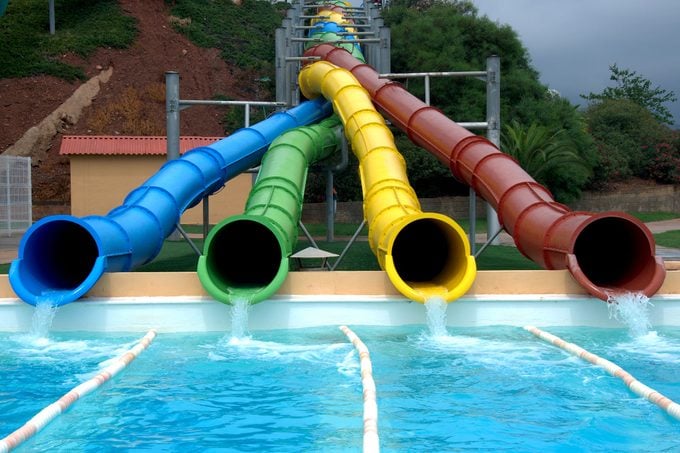
Water parks may appear full of frivolity at first glance, but just like with the crafting of roller coasters, they rely on a whole lot of science—specifically, physics and very technical engineering. These days, computer software keeps water slide aficionados as safe as possible too. The programs analyze friction and mass on each waterslide, which keeps riders spaced evenly in between turns as well as in the optimal spots on each track. As for the constant streams of water on those slides? That’s also all about friction, speed and safety.
A water park requires about a million gallons of water
Water is a precious commodity, so it will probably shock you to learn that it can initially take about 900,000 gallons of the stuff to fill a water park. But after this first fill-up, most of the water will be filtered, treated and recycled, notes Domenic Sicoli, director of design services at WhiteWater, the world’s largest designer and manufacturer of water parks. That means only 2% to 3% of those 900,000 gallons would be needed to keep the park running.
Disney holds the record for the largest wave pool in North America
The wave pool at Disney’s Typhoon Lagoon, located within the Walt Disney World Resort in Orlando, is so darn big that it takes nearly 3 million gallons of water in order for it to be completely filled. For comparison’s sake, an Olympic-size swimming pool holds an estimated 660,000 gallons. And here’s another cool Disney secret: You’ll get to experience 6-foot swells at the lagoon!
Water parks are made up of inventions from all over the world
The water parks we know and love today feature brilliant inventions from all around the world, according to the World Waterpark Association. For instance, the first wave pool was created in Europe, the lazy river and speed slide originated in the Asia-Pacific region of the world and the first waterslide was born in New Zealand. Who knew?!
The fun isn’t just limited to the water parks
Some parks—like Great Wolf Lodge, Aquatopia, Timber Ridge and Avalanche Bay—are part of larger family-friendly resorts that offer both indoor and outdoor activities. If you’re looking to stay dry, many offer everything from exhilarating ropes courses and zip line adventures high above the ground to leisurely tours of the local area. Other resorts offer in-house activities, such as character meet-and-greets, arts and crafts, arcades, mini golf and more. Great Wolf Lodge even has a cool interactive game called MagiQuest, which allows kids to use magic wands to find treasure, befriend treetop pixies and battle an evil dragon.
More than 46 million people visited a water park last year
It’s hard not to love a good water park, as evidenced by the massive amounts of people visiting them each year. And according to the Themed Entertainment Association (TEA), attendance is on the rise around the world. The top 20 water parks in North America welcomed 12.6 million visitors in 2022, up from 10.7 million visitors in 2021. Meanwhile, the top 20 water parks in the Asia-Pacific region saw a whopping 13.7 million visitors in 2022, up from 11.9 million in 2021, and the top 10 European water parks had 10.3 million visitors in 2022, up from 5.1 million in 2021. And those stats don’t include indoor water parks!
There’s a self-proclaimed “Waterpark Capital of the World”
In 1994, hotel owner Stan Anderson created the first indoor water park (yes, ever) in his Wisconsin Dells Polynesian Resort. It was an instant success, and others followed suit quickly—including in Wisconsin Dells. The town, which is less than 20 square miles, has the largest concentration of indoor and outdoor water parks in the world, and it was dubbed the “Waterpark Capital of the World” in 2005.
This Midwest vacation spot boasts a grand total of 21 water parks—including Noah’s Ark, the largest water park in the country—and it will soon be the home of the tallest waterslide in America. The “Icarus” tower will be making its debut in Summer 2024 at the Mt. Olympus Water and Theme Park, along with four other high-thrill body slides.
You’re going to be seeing a lot more water parks
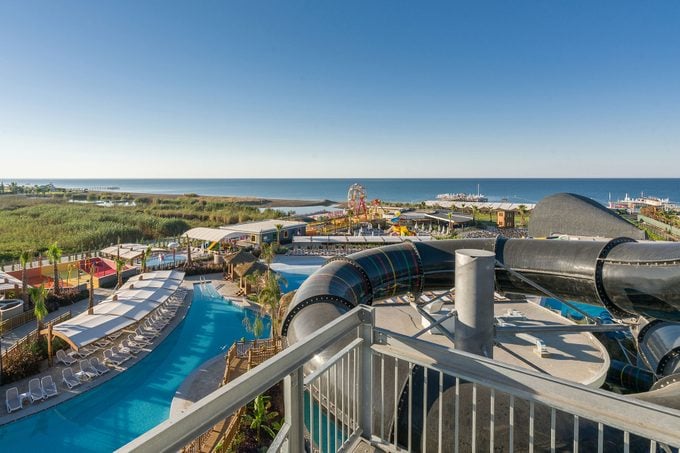
The World Waterpark Association is currently tracking more than 200 projects at new and existing hotels and resorts, and notes that indoor water parks are the fastest-growing segment of the industry. But you won’t just find them at hotels. You’ll also see indoor and outdoor water parks popping up at campgrounds, on cruise ships and even attached to shopping malls, like DreamWorks Water Park in New Jersey.
Swimming isn’t the only exercise you’ll get
Water parks are a great way to get your steps in. They vary in size, but whether you’re visiting the Bahamas’ Aquaventure Water Park, which spans 141 acres, or heading to your nearest indoor water park, which could be anywhere from 120,000 square feet to 220,000 square feet, you can bet you’ll be doing a lot of walking. Not only that, but if you plan on riding the waterslides, you’ll also be climbing crazy amount of stairs. And if you opt to try out a surf machine, such as a FlowRider, you’ll burn even more calories.
Great Wolf Lodge has the largest family of indoor water park resorts
Great Wolf Lodge recently opened its 20th resort in North America—in Perryville, Maryland, to be exact—and the brand doesn’t plan on stopping there. The next resort will open in Collier County, in Southwest Florida, in 2024, and its first U.K. lodge (which will be near Chesterton, a little under two hours away from London) is also in the works. And here’s a bit of fun trivia: The very first Great Wolf Lodge opened in Wisconsin Dells in 1997.
The world’s tallest waterslide is more than 15 stories high
If you want to fly down the tallest waterslide ever built at 62 miles per hour, book a trip to Brazil’s Aldeia das Águas Park Resort and climb a whopping 234 steps to the top of Kilimanjaro. This waterslide holds the Guinness World Record for being the tallest waterslide in the world, and it’s almost 164 feet tall, or the equivalent of 15.5 stories.
But it won’t be the tallest waterslide for long
According to Sicoli, Qatar is about to become home to the world’s tallest waterslide. The Icon Tower at Meryal in Qatar stands at 85 meters, or an astounding 278.87 feet tall. It will also have the largest number of slides (12 of them, to be exact) coming off a single tower. This design, which packs a ton of action into a relatively small footprint, is known as a vertical water park.
The tallest water coaster is right here in the U.S.
What’s the difference between a waterslide and a water coaster? A water coaster uses water boosters or other technologies to boost riders on uphill sections of the ride, whereas a waterslide sends riders, well, down a slide. Currently, Schlitterbahn Galveston Waterpark in Galveston, Texas, holds the Guinness World Record for being the tallest water coaster on the planet. Aptly named MASSIV, it stands 81 feet, 6.72 inches tall, just waiting to be conquered on your next day trip.
Water parks don’t waste as much water as you think they do
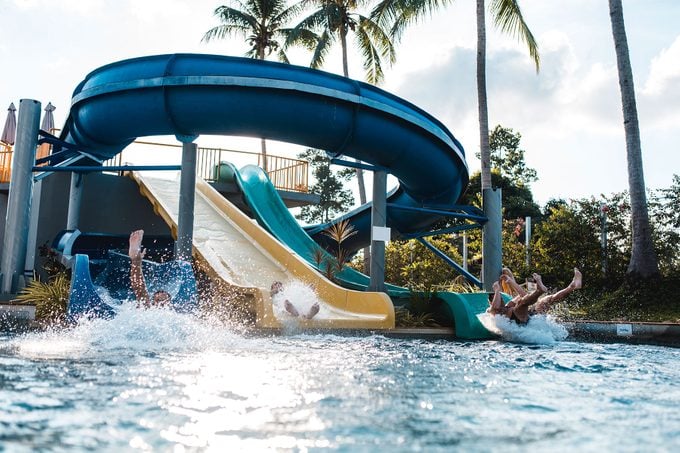
According to Sicoli, water conservation is incredibly important for water parks. “Beyond environmental sustainability, water loss also affects the wallets of park operators,” he explains. That’s why water conservation is factored into the design. WhiteWater’s products, for example, feature “high risers strategically placed to prevent splash-outs, wave catchers in run-out lanes to capture water, smooth entry into landing pools to prevent excess aeration and water coasters with steady water flow to propel riders uphill instead of many small nozzles that cause water to spray everywhere.”
And designers take more than just the rides into consideration. Sicoli points out that water parks may use Life Floor, a foam rubber flooring system that keeps surfaces cooler so water doesn’t evaporate too quickly on a scorching-hot day.
Some golf courses use more water than a water park
Get this: A golf course might actually consume more water than a 100,000-square-foot water park. According to Sicoli, a water park reuses between 97% and 98% of its water. While a 100,000-square-foot water-park resort with lodging and restaurants might use around 125,000 to 160,000 gallons of water per day, the water park itself might use just 18,000 to 24,000 gallons. On the other hand, Sicoli says, “a golf course can consume an average of 300,000 to 500,000 gallons of water per day, depending on region.”
Designing a waterslide is more difficult than designing a roller coaster
That’s because on a roller coaster, passengers are strapped in their ride vehicle, which follows the path of the track and travels at a predetermined speed, regardless of weight, explains Sicoli. On a waterslide, however, additional variables—such as passenger weight, weight distribution, height, friction, water flow and behavior—can affect the speed and trajectory of the ride. Since there are so many variables at play, he stresses the importance of following the rules and properly holding onto mats, inner tubes or rafts.
About the expert
- Domenic Sicoli is the director of design services at WhiteWater, the largest designer and manufacturer of water parks in the world.
Sources:
- World Waterpark Association
- Themed Entertainment Association: “Global Attractions Attendance Report 2022”
- Wisconsin Dells: “Waterpark Capital Credentials”
- Guinness World Records: “Tallest water slide”
- The Park Database: “Deconstructing a Waterpark”

